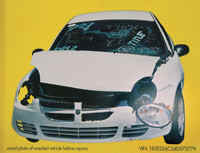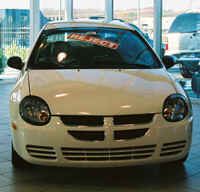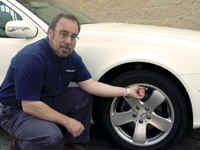Car
Buying Made (Almost) Simple
Story
by Alex Schexnayder, Contributing Writer
For most of us, car shopping ranks as only slightly
more enjoyable than a root canal or a month-long stay with the in-laws. But
since most Virginians rely on
automobiles for their everyday transportation, it is,
like teeth and families, a necessary part of life.
To aid in your next car quest, we have assembled a few
facts and several secrets that should make your next round of vehicle
negotiations � if not downright enjoyable � then at least substantially
less traumatic.
Much of your decision-making takes place long before
you set foot in the showroom. A couple of good sources for car research
include www.consumerreports.org
for unbiased ratings and recommendations and www. edmunds.com, which lists
pricing, as well.
|

BEFORE
Let
the buyer beware. A car restored from this level of damage can be
legally sold -- without disclosure. The history of any vehicle
can be obtained using the vehicle identification number (VIN). The
VIN is located on the edge of the dashboard on the driver's side and
is visible from outside the car through the windshield. There are
several Web sites that for an average fee of $20 will provide a
one-time complete history of any vehicle and for a few dollars more,
unlimited access to car history reports. An online search for
"car history reports" will bring up several of these sites
and a search for "car buying tips" will reveal a further
wealth of information. |
Average drivers, who drive between 12,000 and
15,000 from a mid-sized engine. Drive fewer than 1,000 miles a month?
A smaller engine will give you both economy and performance. If you drive
more than 15,000 miles a year, the larger engine offers performance and
durability.
Durability should be a key determining factor, says Pat
Goss. As the host of Goss� Garage, a live, twice-weekly radio talk show on
WJFK-FM in the Washington, D.C., area and co-host of MotorWeek (a television
fixture for nearly two decades), which airs on nearly 300 PBS stations in
the United States, his knowledge and common-sense approach have helped
millions of car owners gain understanding and confidence about their cars.
�Keep in mind that every automobile has fixed
expenses � insurance, taxes, depreciation,� he says. �If you amortize
these fixed costs over 100,000 miles and then over 200,000 miles, your fixed
cost per mile drops by 50 percent, which will more than cover the cost of
the additional repairs you�re likely to require with an older vehicle.�
|

AFTER |
Narrow your selections to a couple of models you�re
really interested in researching. Then rent each of them for a weekend.
It�s the only way to get a true road test, something the dealer probably
isn�t going to offer. Check out the visibility you have when merging in
city traffic. See how comfortable the car is after a few hours of driving.
Take it for your normal commute.
Now you�re ready for the showroom. Visit a number of
dealerships � even those who represent the same makes. There are many
reasons for this, the most important of which is that it will keep you from
falling in love with a car and blowing the deal.
�Remember, there is nothing out there the regular
person is going to buy that manufacturers didn�t make 10,000 more just
like it,� warns Goss.
If the deal doesn�t go the way you want it to, if you
feel you�re being rushed, or even if you just don�t like the vibe
you�re picking up � walk out at any time. Never be committed to a
specific car until the paperwork is complete.
Shopping multiple dealers will also let you know
who�s hungry. Factory incentives can make a huge difference in the deal
you are able to make. But they change every 30 days, so once you�ve gotten
what you want, snap it up. The rules change when the page on the calendar
does.
We�re all familiar with monthly quotas, but one
factory incentive, called a stair-step program, further affects what the
dealer pays for a car. A typical stair-step works like this: The
manufacturer tells dealers to sell a set number of any model, say 100
Tauruses, in a month. When a dealer sells that magical 100th Taurus, he
earns an extra $150 per car � retroactive to the very first one he sold in
that 30-day period. That�s a cool $15,000.
You want to be the person attempting to buy that 99th
or 100th Taurus, because that puts you in the driver�s seat when it comes
to negotiating. But you don�t know which Ford dealer is close to making
the incentive and which ones are so far away they no longer care this month.
So do your initial tire-kicking any time, but when you�re ready to buy,
always show up at the end of the month, when quotas, stair-steps and other
incentives are about to end.
|

Pat
Goss, automotive expert and radio talk show host, says that
durability should be a key factor when shopping for a new vehicle.
Alex Schexnyder photo. |
Factory orders and dealer exchanges �when another
dealer has just the car you�re looking for, and your hometown dealer will
�trade� him for it � almost never work to your advantage.
Cars already in stock are under a �floor-plan�
interest charge, which the dealer pays every month on the cars he hasn�t
sold. All those commercials aren�t kidding � dealers need to move
current inventory or pay a penalty.
In times past, factory orders were the best way to
ensure the buyer got exactly the options he was looking for. Not so today.
�Unfortunately, manufacturers have gone to option
packages, so you can�t really customize a car with individual options,�
says Goss. �Not only can you not get a sunroof without taking all the
other options in the sunroof package, but chances are very good one of the
dealers you�ll visit already has that model with the sunroof package in
stock.� Meaning you�ll get a better deal, as the dealer tries to
unburden himself from the floor-plan interest charge.
Dealer exchanges, or �DXs,� are designed to work
for the dealer who originally took the car into his stock � not the dealer
with whom you�re negotiating.
Explains Goss, �In addition to the invoice price,
originating dealers receive a �hold-back� discount of between 1 and 3
percent. That hold-back stays with the first dealer. So the receiving
dealer, your dealer, can lose up to 3 percent profit. And guess where he
makes up that difference?�
There are peaks and valleys throughout the year, but
the all-time best month to buy a car is December. Monthly and yearly quotas
come into play, as well as various incentives to dealers. The most notable
of these is the determination of bragging rights as the number one selling
car in America, which provides serious advertising leverage throughout the
following 365 days. Also, effective January 1, dealers must pay an inventory
tax on every car remaining in stock, making December the month it pays them
to offer bargain-basement deals.
Gas-saving options
By the time gasoline hit the $3-a-gallon mark last
year, R.L. Polk�s Center for Automotive Studies found that 55 percent of
respondents said they would change what they drive the next time they are in
the market for a new vehicle. A consistent choice was the hybrid.
�Consumers recognize that they have choices when
facing increasing fuel expenses � hybrids, with both gas and electric
engines, are appealing to many people,� notes the report, published August
22, 2005. �The majority of those in the study (84 percent) said they would
consider buying or leasing a hybrid car.�
The technology behind hybrid electric vehicles (HEVs or
hybrids) allows for much-improved gas mileage and lower emissions while
maintaining the convenience of gasoline-powered cars, trucks and SUVs.
Introduced to the American market in 2000, hybrids have
gained in market share every year since, with an 81 percent hike in 2004
alone as gas prices soared and a wider variety of models attracted
consumers.
Only California tops the Old Dominion in sales of
hybrids. One Virginian who made the switch last year was Dr. Steve Smith,
manager of marketing research and analysis for Southern States Cooperative,
based in Richmond. As you would expect from a person whose work involves
data mining and fact-based analysis, Smith took his time making the
decision.
�Intrigued by the technology, I first looked at
hybrids about four years ago,� he says. �I didn�t buy one then,
primarily because the replacement costs of parts, such as the battery,
weren�t really established � and the best �guesstimate� I could get
was around $5,000.�
Since then, many more hybrid models have been brought
to market; prices for replacement parts have been set and with competition
being what it is, usually at a much lower price point.
Smith�s prime motivation in purchasing his 2005
Toyota Prius was its fuel efficiency, which it delivered through late fall,
when extremely cold temperatures caused a small drop in mileage.
�With a mix of highway and urban driving, I�ve
gotten between 49 and 51 miles to the gallon,� he notes. �The best
I�ve gotten was 56, and the worst, in the very cold we had in early
December, was about 47.�
Equipped with both an internal combustion engine and an
electric motor, a hybrid gains efficiencies by computer-controlled
switching, based on the demands placed on the vehicle.
Toyota Motor Corporation, the first automaker to
introduce most Americans to hybrids, continues to dominate the market.
However, U.S. brands, especially the Ford Escape hybrid, are beginning to
make their presence felt. Chevrolet�s Silverado Extended Cab, the GMC
Sierra Extended Cab, Dodge Ram and Mercury Mariner round out domestic
offerings in the growing automotive niche.
Premiums on a hybrid can range anywhere from about
$4,000 to $10,000 � the high end is for the most luxurious of the hybrid
breed, the Lexus RX400h � more than its traditionally powered counterpart.
Crunch your own numbers, but you�ll likely find that
it will take about six years in fuel savings to recoup the added expense of
the purchase price. Depending on your world view, you�ll have done more
than broken even. By making this environmentally friendly choice, you may
feel you have done your part to make the earth a little-bit-better place.
Can you really put a price on that?
In the Market for a Used Car?
Step into any CarMax dealership and the first thing
you�ll notice is their �Never Sell� vehicle. It�s beautiful, shining
� and potentially dangerous. Beside it is a picture showing how badly
damaged the car was at one time, after an accident.
�These cars have all had their structural integrity
compromised in a substantial impact,� says sales manager David
MacAlexander, an eight-year veteran of CarMax, a national used-car dealer.
�It looks fine, but to the trained eye, it is not sound.�
The bad news is frame (the two parallel rails that
provide the core support of the vehicle) damage leaves a car in a
compromised ability to ride out another wreck.
�If this car were to sustain another impact, it would
not do so as safely as one never damaged,� notes Tyrone Francis, buyer.
�The front end would crumple differently than originally engineered,
probably not protecting the driver as well.�
The good news is that it is easily detectable by the
naked and only semi-trained eye. Think of unwinding a paper clip. You never
get it straight, because it has been crimped. A car�s frame acts in
exactly the same manner. Before you buy any car, ask to have it put on a
lift; examine the frame for �crimps.� Simple, and life-saving.
Things to look for that may indicate
major work has been done: